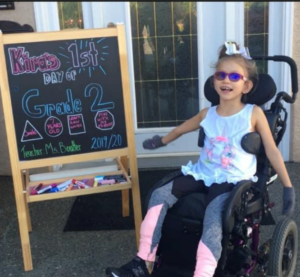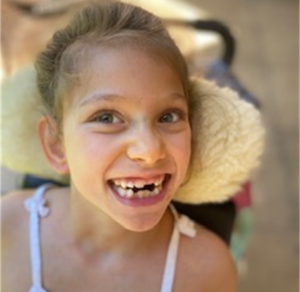In recognition of World Cerebral Palsy Day on October 6th, we are sharing a local story from the heart of the Canadian Rockies about a family who accessed their stored cord blood.
Danica Crawford and her husband were born and raised in Kamloops, British Columbia. When their daughter, Kira, was born, she suffered a hypoxic ischemic event, leading to brain injury. Shortly after her first birthday, Kira was diagnosed with cerebral palsy (CP), a physical disability that affects movement, muscle tone and posture, and impacts 1 in 400 Canadian children.
Key Points:
- Cerebral palsy (CP) is a physical disability that affects movement, muscle tone and posture, and impacts 1 in 400 Canadian children
- Children with various brain injuries, such as cerebral palsy, who have their own, or a sibling’s, cord blood stored in a family bank may now be able to receive stem cell therapy. This option is being provided by Duke University Medical Centre under an expanded access program granted by the US Food and Drug Administration (FDA)
- Cryogenically stored cord blood remains viable for use for decades
“We met another parent who was telling us about cord blood storage and the scientific developments in the field.”
Danica recalls, “When Kira was one, she required surgery. While we were at the hospital, we met another parent who was telling us about cord blood storage and the scientific developments in the field. Of course, we were particularly interested in the research program at Duke University offering cord blood therapy for children with brain conditions such as autism and cerebral palsy.”
In 2014, Danica gave birth to her second child, Grayson, and stored his cord blood with Cells for Life with the hopes of using it to help Kira. Danica reached out to Duke University and they were included on the list of candidates for future clinical trials.
Kira was subsequently accepted into Duke’s Expanded Access Program and was infused with her brother’s cord blood stem cells in August 2019.

Prior to her cord blood stem cell treatment, Kira had previously been through several surgeries and interventions to try to improve Kira’s motor skills. The cord blood infusion Kira received was 41 million cells per kilogram. Danica describes noticing a greater alertness in Kira very soon after – even on the flight home to Canada.
“It was almost like lightbulbs were going off in her eyes.”
It is now 9 months post the cord blood infusion and Kira’s family, friends, and the support staff and teachers at Kira’s school have all noticed improvements. Danica is so proud of her achievements. “Her increased strength and body control is the biggest gain. Her head used to fall down even in her supported wheelchair and we would have to lift it back up for her. We never have to lift her head when she is in her chair anymore, she can realign herself with ease. With effort she can also lift her head sitting and standing now too!”
Significant improvements observed include:
- Greater head control and attention which improves Kira’s ability to drive her power chair
- Increased focus which allows Kira to spend more time in her classroom. Her teachers can conduct better assessments and Kira has been able to demonstrate to her teachers her intelligence, something that was difficult for the school to assess previously. With her increased focus and greater head control, Kira can now read through an entire book with her eye gaze device
- Communication gains, allowing Kira to become more attentive and direct in her responsiveness. Danica is thrilled that Kira now says ‘mom’, which, is was a dream for Danica!

“Kira will say ‘mom’ if she needs me, which is huge to have your child actually ask for you. It is a big deal.”
Life continues to challenge Kira, however, she enjoys playing with Grayson, having dance parties, having her therapeutic horseback rides and trampolining with her parent’s help.
When asked about sharing her experience of the benefits of cord blood banking and cord blood’s therapeutic potential, Danica says, “Absolutely. I always do. I think it’s an important thing for all moms to consider.” She continued, “I think that at any point in time in your child’s life, they might need the cord blood cells for a treatment option. You don’t know how far the science can actually go. When they’re 30, they might need some type of stem cell treatment.”
“I think it’s an important thing for all moms to consider.”

In response to the encouraging clinical outcomes that Kira and her family have experienced from cord blood stem cell treatment, Cells for Life and parent company Cell Care instituted the Cerebral Palsy Sibling Program. The program subsidises fully the processing and ongoing storage of cord blood for siblings of children under the age of 12 who have been diagnosed with cerebral palsy. Over 500 families internationally have collected their child’s cord blood under the program to date. The program’s objective is to ensure all families with children suffering from cerebral palsy have access to potential local and international cord blood clinical trials.
To read more about Kira’s story, follow her journey on Facebook at Kira Shines. For more information about cord blood banking or Cells for Life’s sibling program visit www.cellsforlife.com or www.parentsguidecordblood.org.

